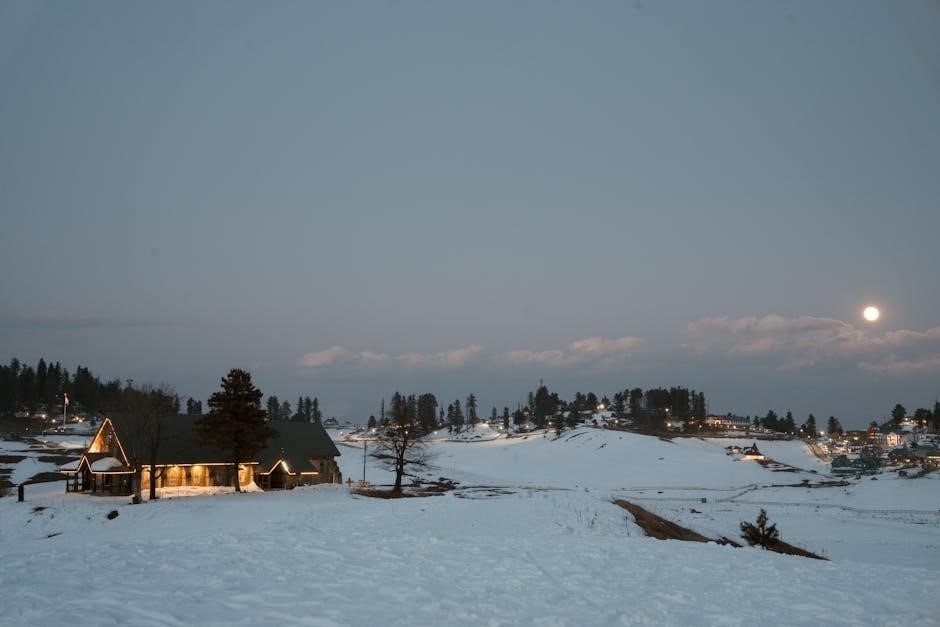
12 mountains in the bible pdf
Mountains in the Bible hold profound spiritual and historical significance, featuring in over 500 references. They symbolize divine encounters, covenants, and transformative events, shaping key narratives across both Testaments.
Significance of Mountains in Biblical Narratives
Mountains in the Bible are often symbolic of divine presence, strength, and transformation. They serve as stages for pivotal events, revealing God’s covenant, judgment, and redemption. From Sinai, where the Ten Commandments were given, to the Mount of Olives, where Jesus prayed and ascended, mountains embody spiritual encounters and life-changing moments. They represent stability and eternity, contrasting human frailty. Many mountains, like Zion, are tied to Israel’s identity and worship, while others, such as Ararat, mark new beginnings. Their prominence underscores themes of faith, obedience, and God’s active role in history, making them central to biblical narratives and spiritual reflections.
The Number 12 and Its Symbolic Meaning in the Bible
The number 12 holds significant symbolic meaning in the Bible, representing completeness, perfection, and divine order. It is associated with the 12 tribes of Israel, the 12 apostles of Jesus, and the 12 gates of the New Jerusalem. In the context of mountains, the number 12 is less directly tied but appears in related narratives, such as the 12 spies sent to explore Canaan (Numbers 13) and the 12 stones erected by Joshua near Mount Ebal (Joshua 4:8). These instances reflect the number’s broader theological significance, emphasizing God’s sovereignty and the structure of His covenant people.

Mountains in the Old Testament
Mountains in the Old Testament are central to key events and theophanies, serving as stages for divine revelations and pivotal moments in Israel’s history.
Mount Sinai: The Mountain of the Ten Commandments
Mount Sinai holds a central place in biblical history as the site where God revealed the Ten Commandments to Moses (Exodus 20:1-17). This mountain, also known as Mount Horeb, was the location of a profound divine encounter, where God established His covenant with Israel. The event marked the foundation of the moral and legal framework for the Israelites. The mountain was shrouded in fire, smoke, and darkness, symbolizing God’s awe-inspiring presence. Moses ascended the mountain multiple times to receive the Law, including the tablets of stone inscribed by God’s finger. Mount Sinai remains a powerful symbol of divine revelation and the establishment of God’s covenant with His people.
Mount Horeb: The Mountain of God’s Presence
Mount Horeb is deeply intertwined with divine encounters, notably Elijah’s experience of the “still small voice” (1 Kings 19:1-18). It symbolizes God’s presence amidst turmoil, offering refuge and revelation. This mountain, also identified with Mount Sinai, was a sanctuary where Moses found solace and communion with God, highlighting its enduring role in biblical narratives as a place of spiritual renewal and divine connection.
Mount Moriah: The Site of Abraham’s Sacrifice
Mount Moriah holds immense significance as the site where Abraham demonstrated unwavering faith by preparing to sacrifice his son Isaac at God’s command (Genesis 22:1-14). This act of obedience became a pivotal moment in biblical history, showcasing Abraham’s trust in God’s promises. The mountain is also associated with the Temple Mount in Jerusalem, linking it to Jewish worship and sacrificial practices. Its historical and spiritual importance underscores themes of faith, sacrifice, and divine provision, as a ram was provided as a substitute for Isaac. Mount Moriah remains a powerful symbol of devotion and God’s intervention in human affairs.
Mount Ararat: The Resting Place of Noah’s Ark
Mount Ararat is biblically significant as the resting place of Noah’s Ark after the great flood (Genesis 8:4). Located in modern-day Turkey, it stands as a symbol of divine deliverance and renewal. The Ark’s landing marked the end of the flood, ushering in a new covenant between God and humanity. This mountain is not only a geological landmark but also a spiritual milestone, representing God’s mercy and the beginning of a fresh start for humanity. Its mention in Scripture underscores its role in biblical history, connecting it to themes of salvation and divine providence.

Mountains in the New Testament
Mountains in the New Testament are pivotal settings for key events, such as the Sermon on the Mount and the Transfiguration, highlighting Jesus’ teachings and divine nature.
The Mount of Olives: A Place of Prayer and Ascension
The Mount of Olives holds deep significance in the New Testament, particularly in the life of Jesus. It was a frequent retreat for Jesus, where He often prayed, as mentioned in Luke 22:39-49. This mount is also the site of His ascension into heaven, as recorded in Acts 1:9-12. The Mount of Olives symbolizes a place of intimate communion with God and serves as a bridge between earthly ministry and divine glory. Its proximity to Jerusalem made it a strategic location for key events in Jesus’ ministry, further emphasizing its spiritual importance in the biblical narrative.
The Mountain of Beatitudes: The Sermon on the Mount
The Mountain of Beatitudes is famously associated with Jesus’ Sermon on the Mount, a pivotal teaching in the New Testament. It is here that Jesus delivered the Beatitudes, a series of blessings that outlined the characteristics of those who would inherit the Kingdom of God. The mountain serves as a symbolic backdrop for spiritual revelation, emphasizing humility, compassion, and righteousness. The teachings conveyed on this mountain shaped Christian ethics and continue to inspire followers of Jesus. Its serene landscape mirrors the profound peace and wisdom imparted during the sermon, making it a revered site in biblical history and Christian devotion.
Mount Tabor: The Traditional Site of the Transfiguration
Mount Tabor is traditionally identified as the site of Jesus’ Transfiguration, a pivotal event in the New Testament. According to the Gospels, Jesus ascended the mountain with Peter, James, and John, where He was transfigured, revealing His divine glory. Moses and Elijah appeared alongside Him, symbolizing the unity of the Old and New Covenants. The disciples, awestruck by the vision, sought to remain there, but Jesus led them back down, emphasizing the mission ahead. Mount Tabor, standing at 588 meters, is a strategic location in Israel and remains a revered pilgrimage site, with churches commemorating the Transfiguration, reflecting its enduring spiritual significance.
Mountains Associated with Key Biblical Events
Biblical mountains like Carmel, Nebo, Gerizim, and Ebal are linked to pivotal events, such as prophetic victories, divine revelations, and the pronouncement of blessings and curses, shaping sacred history.
Mount Carmel: The Battle Between Elijah and the Prophets of Baal
Mount Carmel is renowned for the dramatic confrontation between Elijah and the prophets of Baal. Elijah, a steadfast prophet of the Lord, challenged the 450 prophets of Baal to prove whose deity was true. The people gathered as both sides prepared sacrifices, with neither side lighting the fire. Elijah prayed fervently, and fire from heaven consumed his offering, demonstrating God’s power. This miraculous event led to the defeat of the false prophets and reaffirmed the Israelites’ faith in the one true God. The triumph on Mount Carmel remains a symbol of divine authority and the unwavering faith of Elijah.
Mount Nebo: The Mountain from Which Moses Viewed the Promised Land
Mount Nebo holds a significant place in biblical history as the site from which Moses was allowed to glimpse the Promised Land before his death. Located in modern-day Jordan, it is where God showed Moses the vast expanse of the land He had promised to the Israelites. Despite leading his people for decades, Moses was not permitted to enter the land due to past disobedience. Instead, he viewed it from afar, a poignant reminder of faith and obedience. After his death, Moses was buried in an unknown location near Mount Nebo, adding to its sacred legacy in the biblical narrative.
Mount Gerizim: The Mountain of Blessings
Mount Gerizim is deeply rooted in biblical history as a symbol of blessings and divine covenant; It is famously known as the mountain where Joshua led the tribes of Israel to pronounce blessings upon the people, as instructed by Moses. This sacred ceremony, recorded in Joshua 8:33-35, marked the renewal of God’s covenant with His people. Gerizim is also associated with the Samaritan tradition, where a temple once stood, though it was later destroyed. Today, Mount Gerizim remains a site of historical and spiritual significance, often visited by pilgrims seeking to connect with its rich biblical heritage and the promise of divine favor it represents.
Mount Ebal: The Mountain of Curses
Mount Ebal, situated in modern-day Israel, holds a significant place in biblical history as the mountain of curses. According to Deuteronomy 11:29 and 27:13, the tribes of Israel gathered on Mount Ebal and Mount Gerizim to pronounce blessings and curses, respectively. The Levites read the law from Mount Ebal, warning the people of the consequences of disobeying God’s commandments. This solemn ceremony underscored the importance of obedience and the gravity of sin. Mount Ebal also served as a reminder of God’s covenant with His people, symbolizing both judgment and the need for repentance. Its role in biblical narratives highlights its enduring spiritual significance.
Mountains Mentioned in the Psalms and Proverbs
The Psalms and Proverbs frequently reference mountains as symbols of strength, stability, and divine presence, reflecting their enduring significance in biblical wisdom and worship traditions.
Mount Zion: The Spiritual Heart of Jerusalem
Mount Zion, often referred to as the City of David, holds immense religious significance in the Bible. It is frequently mentioned in the Psalms and Proverbs as a symbol of God’s presence and covenant with His people. The mountain is closely associated with Jerusalem, serving as both a historical and spiritual cornerstone. In the Old Testament, it is the site of King David’s reign and the Ark of the Covenant’s resting place. In the New Testament, it is linked to Jesus’ ministry and the outpouring of the Holy Spirit. Zion’s enduring legacy as a place of worship and divine encounter continues to inspire believers today;
Mount Hermon: The Mountain of Divine Encounters
Mount Hermon, the highest peak in the region, is a significant biblical site often associated with divine encounters. Located near the border of modern-day Israel, Lebanon, and Syria, it is mentioned in Psalm 89:12 and other scriptures. The mountain is symbolic of strength and stability, often linked to God’s presence and power. In biblical narratives, Hermon is also connected to the Sidonians and other ancient groups. Its snow-capped summit has made it a striking natural wonder, representing God’s majesty. Today, it remains a site of spiritual reflection and pilgrimage, embodying the enduring connection between nature and divine revelation in the Bible.

Mountains in Prophetic Visions
Mountains symbolize God’s kingdom and divine authority in prophetic visions; They represent strength, stability, and the fulfillment of God’s redemptive plans, often serving as centers of worship and revelation.
Mountains as Symbols of God’s Kingdom
Mountains in the Bible are often depicted as symbols of God’s kingdom, representing strength, stability, and divine authority. They serve as stages for pivotal events, such as the Sermon on the Mount and the Transfiguration, where Jesus revealed His divine nature. In prophetic visions, mountains are frequently associated with God’s presence and the establishment of His eternal reign. For instance, Isaiah’s vision of the Mountain of the Lord’s House emphasizes a future where all nations unite under God’s rule, signifying peace and harmony. Thus, mountains embody the enduring and unshakeable nature of God’s kingdom, reflecting His sovereignty and redemptive plan for humanity.
The Mountain of the Lord’s House in Isaiah’s Vision
In Isaiah’s vision, the Mountain of the Lord’s House is a central symbol of God’s ultimate authority and redemptive plan. Described as the highest of all mountains, it represents the earthly manifestation of God’s kingdom, where His law and justice will flow to all nations (Isaiah 2:2-4). This mountain is not just a physical location but a spiritual emblem of God’s reign, emphasizing unity, peace, and the abolition of warfare. It signifies the messianic age, where God’s presence will be universally acknowledged, and His people will gather to worship Him. This vision underscores the mountain’s role as a divine throne and a source of eternal hope.
Mountains in the Life of Jesus
Mountains played a significant role in Jesus’ ministry, serving as places of prayer, teaching, and key events like the Sermon on the Mount and His transfiguration.
Jesus’ Prayer on the Mountain
Jesus often retreated to mountains to pray, seeking solitude and communion with God. These moments were crucial for His spiritual renewal and preparation for ministry. In Matthew 14:23 and Mark 6:46, Jesus ascends a mountain to pray after feeding the multitudes, demonstrating His dependence on God. Similarly, in Luke 6:12, He spends the night praying on a mountain before selecting His disciples. The Mount of Olives, mentioned in Luke 22:39-49 and Acts 1:9-12, was another frequent place of prayer, where He poured out His heart to the Father. These mountain prayers highlight Jesus’ deep connection with God, emphasizing the importance of prayer in His life and ministry.
The Mountain Where Jesus Was Transfigured
The Transfiguration of Jesus occurred on an unnamed mountain, where He revealed His divine glory to Peter, James, and John. Accompanied by Moses and Elijah, Jesus’ appearance transformed, and a voice from heaven affirmed Him as the Son of God. This event, recorded in Matthew 17:1-13, Mark 9:2-13, and Luke 9:28-36, symbolizes a pivotal moment in Jesus’ ministry, reinforcing His identity and mission. The mountain setting emphasized the sacredness and isolation of the experience, providing a powerful visual of Jesus’ connection to God and His divine purpose. This transformative event strengthened the disciples’ faith and prepared them for the challenges ahead.
Mountains in the Life of Moses
Moses’ journey with God unfolded on significant mountains, including Sinai, where he received the Ten Commandments, and Nebo, where he viewed the Promised Land before his death.
Moses on Mount Sinai: Receiving the Law
Moses ascended Mount Sinai, where he received the Ten Commandments from God, establishing the covenant with Israel. This event marked a pivotal moment in biblical history, shaping the moral and legal foundations of the Israelites. The encounter emphasized God’s presence and authority, with divine instructions engraved on stone tablets. The experience on Sinai not only solidified Moses’ role as a leader but also underscored the mountain’s symbolic significance as a place of divine revelation and covenant-making. This event remains central to both Jewish and Christian traditions, highlighting the importance of obedience and faith in God’s commands.
Moses’ Final View of the Promised Land from Mount Nebo
From Mount Nebo, Moses gazed upon the Promised Land, a moment of profound fulfillment before his death. God allowed him to see the land He had sworn to Abraham, Isaac, and Jacob, symbolizing the fulfillment of His covenant. Though Moses did not enter the land, this view represented the completion of his life’s purpose. The event underscores themes of faith, obedience, and trust in God’s promises. Mount Nebo stands as a testament to divine faithfulness and the enduring legacy of Moses’ leadership, marking the end of an era in Israel’s history.
Mountains in the Life of Abraham
Mount Moriah stands as the site of Abraham’s ultimate test of faith, where he prepared to sacrifice Isaac, trusting God’s promise and provision.
Mount Moriah: The Test of Faith
Mount Moriah, a pivotal site in biblical history, is where Abraham faced his ultimate test of faith. According to Genesis 22, God instructed Abraham to offer his son Isaac as a sacrifice. This mountain, later identified as the location of Solomon’s Temple, symbolizes unwavering trust in divine promises. Abraham’s obedience, despite the immense emotional challenge, demonstrated his deep faith in God’s plan. The narrative underscores themes of surrender, trust, and divine intervention, as an angel halted the sacrifice, providing a ram as a substitute. This event remains a cornerstone of faith in Jewish, Christian, and Islamic traditions, illustrating the profound trust required in a covenant relationship with God.
Mountains in the Life of Elijah
Elijah’s ministry was marked by divine encounters on mountains, notably Mount Carmel, where he triumphed over the prophets of Baal, reaffirming God’s power and sovereignty.
Mount Carmel: The Triumph of God
Mount Carmel is renowned for Elijah’s dramatic confrontation with the prophets of Baal, showcasing God’s supremacy. Elijah challenged the prophets to a test, preparing an altar and calling upon God to ignite the sacrifice. Despite the prophets’ frantic rituals, their gods remained silent. Elijah’s prayer was answered with fire from heaven, consuming the offering and confirming the Lord’s power; This miraculous event solidified Elijah’s role as a prophet and Mount Carmel as a symbol of divine triumph. The mountain stands as a testament to unwavering faith and God’s intervention in human affairs, resonating deeply in biblical history.

Mountains in the Life of Jesus’ Ministry
Jesus often retreated to mountains for prayer and solitude, emphasizing their significance in His ministry. These moments prepared Him for critical teachings, such as the Sermon on the Mount.
The Sermon on the Mount: Teachings from the Mountain
Jesus delivered the Sermon on the Mount, a foundational teachings collection, from an unnamed mountain. This sermon, recorded in Matthew 5-7, includes the Beatitudes, the Golden Rule, and lessons on love and forgiveness. It emphasized spiritual growth over outward righteousness, shaping Christian ethics. The mountain setting symbolized a place of divine authority and intimacy with God, reflecting Jesus’ connection to Old Testament prophets who also received revelations on mountains. This event underscores the significance of mountains as platforms for divine communication and transformation, leaving a lasting legacy in Christian teachings and practices.

Mountains as Symbols in the Bible
Mountains symbolize strength, divine presence, and enduring stability. They represent God’s covenant and serve as sacred spaces for worship, sacrifice, and spiritual encounters, shaping biblical narratives.
Mountains as Places of Worship and Sacrifice
Mountains in the Bible often served as sacred spaces for worship and sacrifice, symbolizing closeness to God. Mount Sinai, where Moses received the Ten Commandments, stands as a pinnacle of divine revelation. Similarly, Mount Moriah, the site of Abraham’s willingness to sacrifice Isaac, represents faith and obedience. Other mountains, like Mount Zion, became central to Israel’s worship, housing the Temple. These high places were not just physical elevations but spiritual hubs, where humanity encountered God. Sacrifices and prayers on mountains underscored their role as bridges between heaven and earth, emphasizing their enduring significance in biblical devotion and worship practices.
Mountains as Symbols of Strength and Stability
Mountains in the Bible symbolize strength and stability, often representing God’s enduring presence and power. Their unshakable nature reflects divine reliability, as seen in Psalms where mountains are described as immovable. Mount Sinai, the site of the Ten Commandments, embodies God’s steadfast covenant with Israel. Similarly, Mount Zion, associated with Jerusalem, signifies God’s eternal reign and stability. Jesus’ Sermon on the Mount further reinforces this imagery, as His teachings provide a moral foundation akin to an unshakeable mountain. These symbols inspire trust in God’s unwavering promises and sovereignty, making mountains powerful representations of strength and stability in biblical narratives.
Modern-Day Significance of Biblical Mountains
Biblical mountains continue to inspire spiritual reflection and pilgrimage, attracting millions seeking connection to sacred history and divine presence, fostering faith and cultural heritage globally.
Pilgrimage and Tourism: Visiting Biblical Mountain Sites
Biblical mountains attract millions of pilgrims and tourists annually, drawn by their spiritual and historical significance. Sites like Mount Sinai, where Moses received the Ten Commandments, and the Mount of Olives, linked to Jesus’ ascension, are pivotal destinations. Mount Ararat, resting place of Noah’s Ark, and Mount Nebo, where Moses viewed the Promised Land, also hold deep religious and cultural meaning. Visitors seek connection to sacred narratives, often combining faith with exploration. These mountains serve as bridges between ancient stories and modern devotion, offering a tangible link to biblical events and enduring spiritual inspiration.
Mountains in the Bible are sacred spaces central to key events and divine encounters, symbolizing God’s presence and covenant, leaving a lasting legacy in faith and culture.
Summarizing the Role of Mountains in the Bible
Mountains in the Bible are sacred spaces where divine encounters and transformative events unfold, symbolizing God’s presence, strength, and covenant. They serve as backdrops for key narratives, from the giving of the Law on Mount Sinai to Jesus’ Sermon on the Mount. These elevated lands often represent spiritual heights, places of worship, and sacrifice, emphasizing their role in shaping Israel’s identity and Christian theology. The prominence of mountains underscores their enduring symbolic and historical significance, reflecting God’s interaction with humanity and the establishment of sacred covenants. Their mention in both Testaments highlights their timeless importance in biblical storytelling and theological themes.
The Enduring Legacy of Biblical Mountains
Biblical mountains leave an enduring legacy as sacred symbols and historical landmarks, inspiring faith and pilgrimage. Their stories, embedded in Scripture, continue to influence spirituality, art, and culture globally. From Mount Sinai’s role in shaping Israel’s identity to the Mount of Olives’ significance in Jesus’ ministry, these sites remain powerful reminders of God’s presence and covenant promises. Today, they attract millions, bridging ancient narratives with modern devotion. Their impact endures, reflecting the timeless connection between faith, history, and geography, ensuring their relevance for future generations seeking spiritual guidance and historical insight.